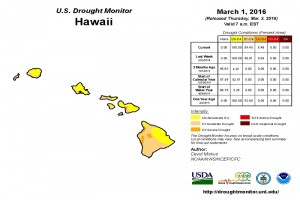El Nino Creating Severe Drought Conditions

This map, released Thursday by the United States Drought Monitor, shows the levels of drought across the state. Photo credit: The National Drought Mitigation Center.
The unusually dry conditions seen around the Big Island aren’t expected to change anytime soon.
A strong El Nino climate cycle continues to keep wet weather away from much of the state, especially the Big Island, in what would typically be considered a wet season, and forecasters from the National Weather Service don’t see much changing over the next few weeks.
The United States Drought Monitor announced Thursday that the entire state is facing at least some form of drought conditions, with the worst being seen in portions of West Hawai’i and West Maui, where conditions are being described as “severe.”
Drought conditions vary on the Big Island, similar to the other islands in the chain. Much of East Hawai’i and a small section of North Hawai’i is facing the lowest drought level, considered “abnormal.” The rest of the island, outside of the small severe sections, is under a “moderate” drought level.
The entire state has been under at least some level of drought conditions since early February, with the amount of areas facing more severe conditions increasing every week.
According to Thursday’s drought update, the Farm Service Agency reported that pasture conditions had worsened in the last few weeks, pushing the drought level up to severe in two different leeward spots on the Big Island.
The drought level increased to moderate in many portions of the Big Island, including the western slopes of North Kohala, South Kohala, North Kona, South Point, and Pohakuloa.
Feeling the impact is leeward-area farmers. A drought information statement from the National Weather Service states that coffee farmers, especially in Kona, are seeing a largely dormant period because of the lack of rainfall.
Residents on catchment systems are also feeling the effects of the dry conditions, as there has been little to no rain to fill up their water tanks. For many, it means money out-of-pocket to hire a hauling service to deliver water to their homes to cover basic necessities.
NWS meteorologist Kevin Kodama says that the potential of some much-needed rain in West Hawai’i is not likely anytime soon, and the typically wet season between October and April will instead see an increase in drought conditions over the next few weeks.
A reprieve could come later in the year. The National Oceanic and Atmospheric Administration’s Climate Prediction Center expects El Nino conditions to weaken sometime during the Spring or early Summer seasons. An unusually cold climate cycle, known as La Nina, could make its way over the islands in the Fall.












